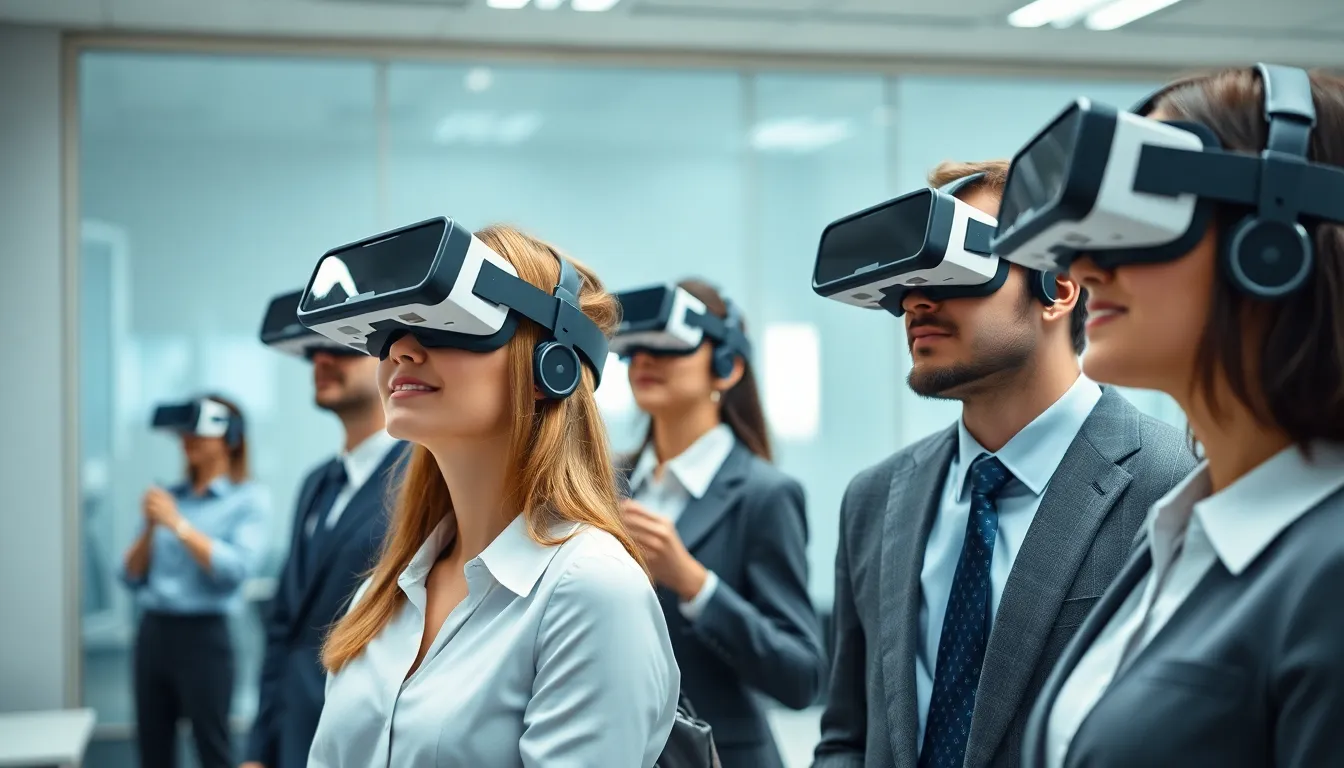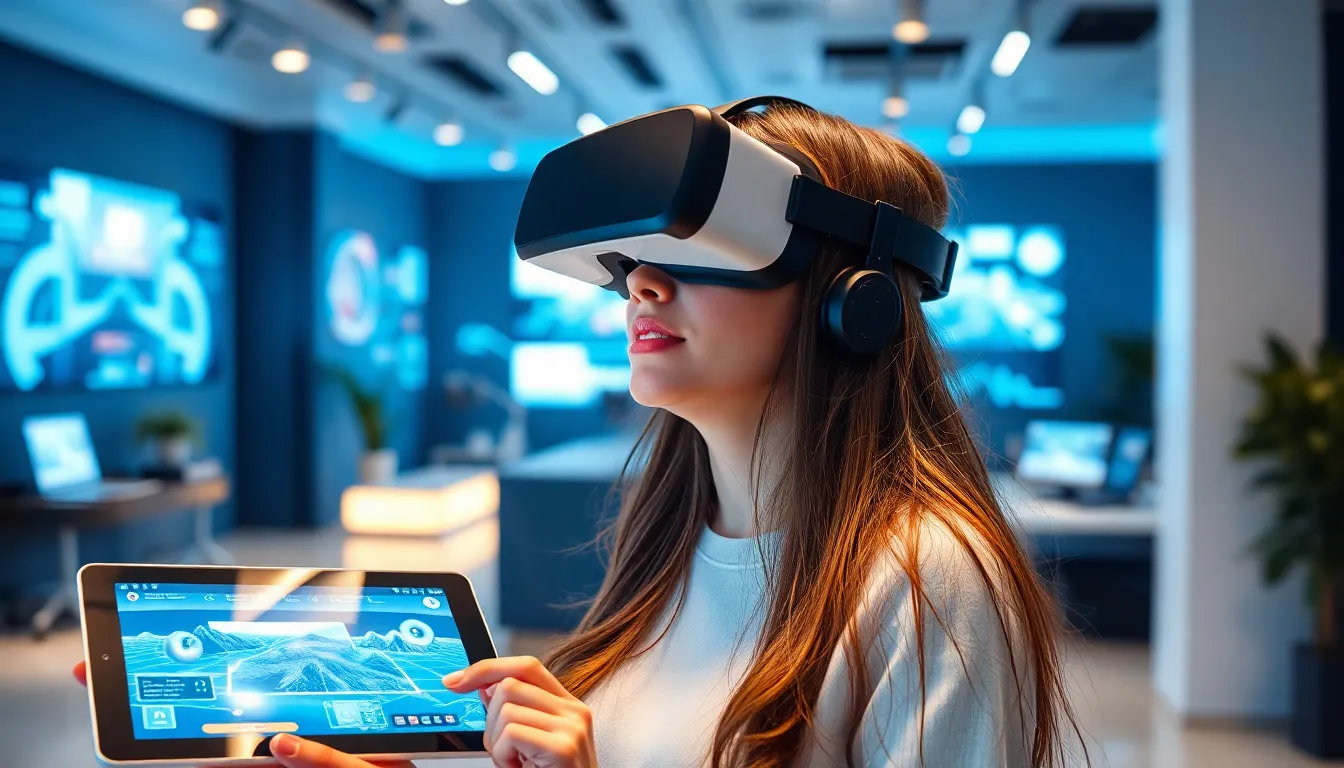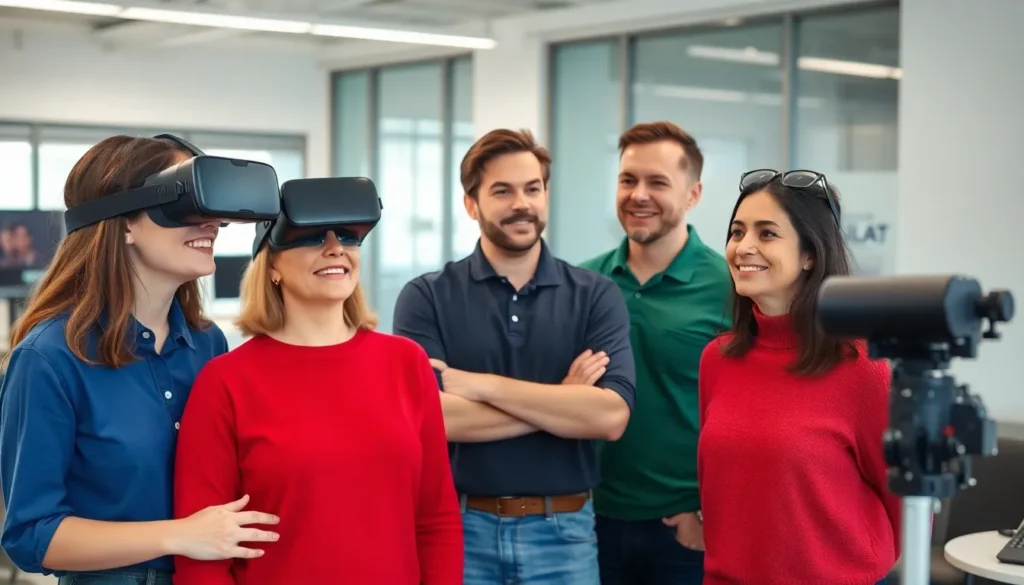Table of Contents
ToggleIn a world where training often feels like a snooze-fest, VR training solutions are shaking things up faster than a double shot of espresso. Gone are the days of dull lectures and endless PowerPoint slides. With virtual reality, employees can dive into immersive experiences that make learning not just effective but downright fun. Imagine stepping into a virtual world where mistakes don’t just happen—they’re part of the learning journey, and no one gets hurt.
By harnessing the power of VR, companies can equip their teams with skills that stick, all while keeping boredom at bay. It’s not just about training; it’s about transforming the way we learn. So, buckle up and get ready to explore how VR training solutions are revolutionizing employee development, one headset at a time.
Overview of VR Training Solutions
VR training solutions utilize immersive technology to foster engaging learning environments. These solutions create realistic scenarios, enabling employees to practice skills in a safe space. Companies implement VR training to enhance retention of critical knowledge through experiential learning.
Cost efficiency becomes apparent when evaluating VR applications. Traditional training often incurs high expenses due to materials and time away from work. In contrast, VR minimizes these costs by providing scalable, reusable training modules.
Diverse industries adopt VR training for various applications. Healthcare professionals use VR to simulate surgeries, while manufacturers train workers on equipment handling. This versatility contributes to a wide acceptance across sectors.
Enhanced engagement stands out as a key benefit of VR training. Participants experience interactive simulations that actively involve them in the learning process. By fostering a dynamic environment, VR solutions encourage knowledge retention and promote skill application.
Real-time feedback contributes to the effectiveness of VR training. Learners receive immediate responses to their actions, allowing for instant corrections and improvements. This feature accelerates skill development and builds confidence.
Research supports the efficacy of VR training. Studies indicate that VR learners retain up to 75% of information compared to 10% from traditional methods. These findings highlight VR’s potential to revolutionize employee training and development.
Organizations embracing VR training solutions position themselves as leaders in innovation. By harnessing cutting-edge technology, companies improve workforce competencies while enhancing employee satisfaction.
Benefits of VR Training Solutions

VR training solutions provide significant advantages that transform employee development. They enhance learning retention and create realistic training environments.
Enhanced Learning Retention
Learners engage more deeply with VR training solutions, leading to greater retention of information. Studies demonstrate VR learners can retain up to 75% of information, a stark contrast to the mere 10% retention from traditional methods. This approach allows employees to practice skills in immersive settings where trial and error contribute to learning. Participants find it easier to understand complex concepts when they experience them firsthand. Enhanced retention fosters increased confidence and competence in their roles, ultimately benefiting organizations that invest in VR training.
Realistic Training Environments
VR training solutions offer realistic environments that simulate real-world scenarios. Employees can experience various situations without the risk associated with on-the-job training. This immersive approach allows them to face challenges in a controlled setting, effectively preparing them for actual job demands. Various industries, such as healthcare and manufacturing, utilize these environments to improve skills and decision-making abilities. Realistic training cultivates a sense of familiarity and comfort, helping employees transition seamlessly into their responsibilities. By integrating VR, organizations boost overall training effectiveness and workforce readiness.
Key Features of Effective VR Training Solutions
Effective VR training solutions incorporate various features that enhance learning experiences. Organizations benefit significantly from using immersive simulations and customization options.
Immersive Simulations
Immersive simulations create dynamic environments that mimic real-world scenarios. Participants feel present in the context, leading to deeper engagement. Employees can practice skills without real-world consequences, which fosters confidence. Such environments encourage experimentation and learning from mistakes. Research supports that learners in VR retain up to 75% of information, making these simulations highly effective. This interactive nature transforms monotonous training into engaging experiences. As a result, employees become better prepared for actual job demands.
Customization Options
Customization options allow organizations to tailor training experiences to specific needs. Adaptable content meets the varying requirements of different roles and industries. Trainers can adjust scenarios, difficulty levels, and learning objectives easily. Feedback from employees can also guide modifications to improve relevance and effectiveness. Such flexibility ensures that training remains aligned with organizational goals and workforce development. Enhanced engagement through personalized content promotes higher retention rates. Ultimately, tailored VR training solutions drive impactful learning outcomes.
Industries Utilizing VR Training Solutions
Various industries are embracing VR training solutions for enhanced employee development. These industries effectively leverage immersive technology to improve learning.
Healthcare
Healthcare professionals turn to VR training to simulate real-life medical scenarios. Surgeons practice complex procedures in a risk-free environment, which significantly reduces the chance of errors in actual operations. Medical students engage in realistic patient interactions, honing their bedside manner and diagnostic skills. Research reveals that VR training can decrease training time by up to 40%, allowing practitioners to acquire essential skills quicker than traditional methods. Furthermore, healthcare organizations benefit from constant updates in VR content, ensuring that training remains aligned with current practices and standards.
Manufacturing
Manufacturing companies utilize VR training to enhance safety and operational efficiency. Employees experience immersive simulations that replicate machinery operation and safety protocols. This hands-on approach enables workers to familiarize themselves with equipment without the risk of injury. Studies indicate that VR training can decrease workplace accidents by nearly 30%, significantly improving overall safety. Companies enjoy the advantage of customizable training programs tailored to specific machinery, ensuring that employees gain relevant experience. By integrating VR, manufacturing firms not only streamline their onboarding processes but also foster a culture of continuous improvement.
Implementation Considerations
Implementing virtual reality (VR) training solutions involves careful attention to various considerations. Cost factors and technical requirements play crucial roles in ensuring successful integration.
Cost Factors
Organizations must evaluate the initial investment associated with VR technology. Hardware costs can range from $300 to $1,500 per headset, depending on the type and features. Additionally, developing immersive training content may involve expenses that vary based on complexity, with estimates typically between $5,000 and $50,000. Licensing fees for software platforms also impact budgeting. Savings from reduced training time and improved employee performance may offset expenses, making VR solutions financially viable. Evaluate the long-term return on investment (ROI) to measure overall effectiveness.
Technical Requirements
Technical requirements are essential for optimal VR training implementation. High-performance computers or consoles support smooth operation and detailed graphics. A minimum of 8GB RAM and robust graphics cards, such as NVIDIA GTX series, enhance user experience. Appropriate software platforms are necessary for content creation and delivery, with many organizations opting for custom development. Reliable internet connectivity ensures seamless access to updated content and features. Training staff on using VR equipment and software promotes successful integration and utilization in daily training activities.
The rise of VR training solutions marks a significant shift in how organizations approach employee development. By embracing immersive experiences, companies can foster a more engaging learning environment that not only enhances retention but also builds confidence among employees.
As industries continue to adopt these innovative training methods, the potential for improved performance and safety becomes increasingly apparent. Organizations that invest in VR training are positioning themselves at the forefront of workforce development, ensuring they’re prepared for the challenges of tomorrow.
With the right implementation and a focus on customization, VR training can lead to substantial long-term benefits, making it a smart choice for any forward-thinking organization.







